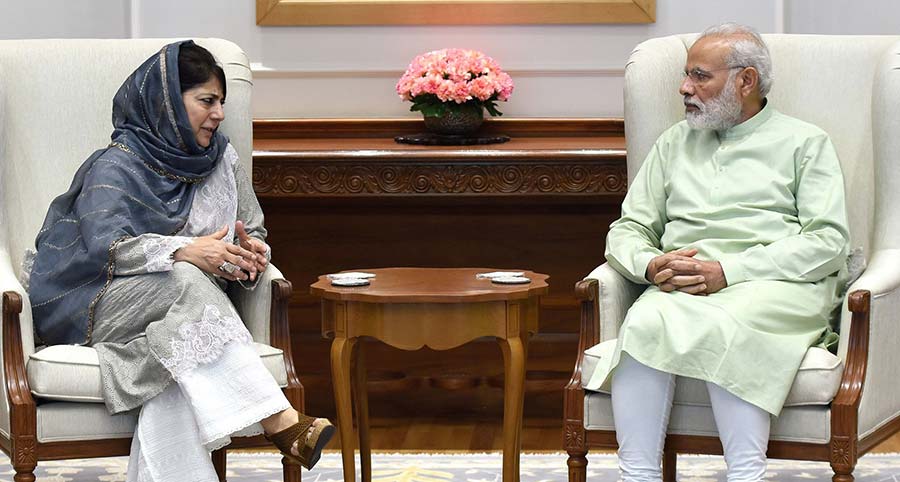By Khursheed Wani

Contrary to his 2016 speech on August 15, Prime Minister Narendra Modi this time spoke directly about Kashmir and the plight of its people. In 2016, the issues about Baluchistan (Pakistan) were raised and claims were staked emphatically on the territories of Gilgit and Baltistan. This time, there was no mention of these areas, reflecting a seminal change on the ground. Taking the fight to enemy’s courtyard did not seem to have worked. Consequently, the focus returned to the territory that India controls. The standoff in Doklam with China and its ripple-effect in Ladakh region is one of the major reasons for the shift.
In the backdrop of explosive situation within Kashmir and the border areas of the state, it was least expected that Modi would appear to be softer or exhibit empathy. He surprised the audience by saying “Kashmir ki samasya goli ya gali say nahi, galay laganay se hal hogi (The Kashmir issue can’t be resolved with bullets or abuses. It can be solved with passionate hugs)”.
Only a week before Modi’s Red Fort speech, Chief Minister Mehbooba Mufti had rushed to Delhi to plead with him that the special status of J&K must be safeguarded in the spirit of Agenda of Alliance, the roadmap BJP and PDP chalked out in March 2015 for an unusual coalition. A legal recourse taken by an NGO, known for its proximity to rightwing Hindu organization, for scrapping Article 35A of the Indian constitution that grants special privileges and exclusive rights to J&K citizens, has emerged as the major challenge to the Mehbooba’s government. She claimed that she received assurances on safety to the special status but her claim was not corroborated by any statement from the PMO. If Modi’s August 15, speech has any reference to the special status, it is quite vague and indistinct.
It is a fact that political and strategic dynamics changed in an unprecedented way in J&K since Modi too over the reigns of power in Delhi. The PDP might have entered into the coalition with its own outlook but the Modi government’s unconventional handling of issues, forced the ruling party to buckle.
Burhan Wani killing and its aftermath catapulted the PDP into a highly precarious position. Safeguarding the chair became the priority rather than securing those ‘ideals’ the party leadership had trumpeted to uphold for many years. In the scenario that emerged, Kashmir witnessed unbridled killing of civilians—protesters and bystanders, a blinding epidemic enforced on youngsters targeted with pellet guns, complete ban on political activities of the dissenters and filling up jails and police lock-ups with anyone and everyone who dared to challenge the unprecedented onslaught.
To top it all, Delhi based media, especially TV, embarked upon an orchestrated campaign to vilify Kashmir, its defiant people and pro-freedom leadership. It is quite documented as to how the TV channels ran the smear campaign for months together to fuel an anti-Kashmiri narrative. The NIA crackdown on the separatist leadership was timely and best suited for this narrative.
It is in this backdrop, the common Kashmiris weigh Modi’s goli and gali talk. It could be a realisation that bullets fired indiscriminately for the past 13 months killing and maiming scores of armed insurgents and civilians have not changed the ground situation. It could be the understanding of the ground reality that propaganda unleashed by the TV has only increased the resentment within the population.
But interestingly, Modi’s statement did not evoke an overwhelming response in Kashmir. Mehbooba Mufti did not refer to the statement during her brief speech at Bakshi Stadium. Perhaps she had not watched it leaving her office to issue a laudatory statement later. Omar Abdullah wanted it to be tested on the ground level and separatists, predictably, remained sceptical. Mirwaiz Umar Farooq guardedly welcomed the gesture and sought concrete measures on the ground level.
Modi’s trusted minister’s Rajnath Singh and Arun Jaitley, who are directly involved in Kashmir affairs for the portfolios they hold, have been quite vocal on the military solution of Kashmir. They want to fight militancy till the last insurgent.
During the past several months, a hot pursuit against militancy has been underway. A number of militants including top-ranking commanders, Abu Dujana, Yasin Yattu alias Mehmood Ghaznavi and Ayub Lelhari were killed. The sustained anti-militancy campaign has shattered the militancy and lowered the morale of its back-up grid. There is no ground evidence that militancy can regain strength in foreseeable future in the backdrop of firmed up intelligence network, curbed ingress along LoC, police’s renewed anti-militancy activism and dwindling number of militants.
This sets ideal stage for Delhi to pick up threads in Kashmir a new presence or absence of militants on the ground level is no measure of peace and tranquillity because the issue of Kashmir is essentially political. This highlights the need for initiation of a sustainable process of engagement at all levels.
(The author is a senior journalist)














